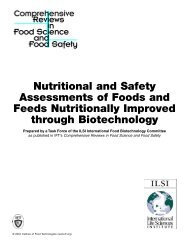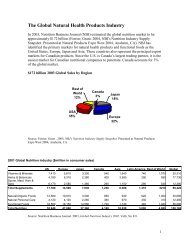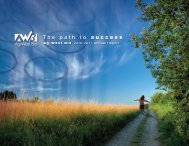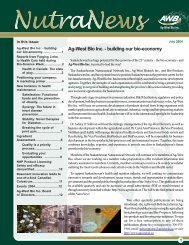Beyond Borders: Global biotechnology report 2010
Beyond Borders: Global biotechnology report 2010
Beyond Borders: Global biotechnology report 2010
Create successful ePaper yourself
Turn your PDF publications into a flip-book with our unique Google optimized e-Paper software.
Venturing forth with creative approaches<br />
The biotech industry has gone through<br />
several funding cycles, ranging from<br />
optimism and financial abundance to<br />
severe capital scarcity. In 1999 and<br />
2000, many companies were formed<br />
with medium-sized financial injections<br />
followed by several follow-on rounds with<br />
new investors at higher valuations and<br />
an IPO as the intended exit. This model<br />
ended after the bursting of the genomics<br />
bubble. With follow-on venture investors<br />
facing “down rounds,” the focus shifted<br />
to assembling a strong syndicate from<br />
the beginning that could support the<br />
company for several years. However, this<br />
model worked best in the US, where there<br />
are more investors with the requisite<br />
experience, deep pockets and risk appetite.<br />
In Europe, the model has instead largely<br />
been one of “drip feeding” companies.<br />
Of course, things have become dramatically<br />
more difficult in the last one to two years.<br />
In both Europe and North America, VCs<br />
are often struggling to participate in<br />
follow-on rounds, since it is taking more<br />
time and money than originally anticipated<br />
to carry a company to a healthy exit, and<br />
many funds — including some very respected<br />
names — have had trouble raising<br />
fresh capital.<br />
In response, biotech companies have<br />
lowered their burn rates, sometimes even<br />
at the expense of promising R&D projects.<br />
Alternatively, companies are trying to<br />
partner their assets earlier than originally<br />
anticipated. This might seem the best<br />
option in a stressed situation, but having<br />
investors with financial strength to develop<br />
assets often creates much more value for<br />
shareholders. Similarly, in exits through<br />
acquisition, stressed investor syndicates<br />
might be forced to sell companies<br />
prematurely at excessively low valuations.<br />
Creative approaches for challenging<br />
times<br />
Novo Ventures has a funding structure<br />
and financial strength well suited for<br />
these challenging times. In an increasingly<br />
tight capital environment, we are often<br />
using very lean or semi-virtual company<br />
operations. For instance, we founded<br />
Thiakis with a co-investor in 2006 based<br />
on some interesting molecules involved in<br />
appetite regulation from London’s Imperial<br />
College. From the start, the company<br />
was run as a focused project with a lean,<br />
almost virtual, organization. The idea was<br />
to simply find the best molecule in terms<br />
of pharmacokinetics, weight loss and side<br />
effects. Our plan — to sell the company if it<br />
successfully completed Phase IIa trials — was<br />
borne out when we sold Thiakis to Wyeth<br />
in December 2008. Wherever possible, we<br />
are looking for similar approaches in today’s<br />
market. In a recent case from <strong>2010</strong>, we<br />
sold the company Novexel to AstraZeneca.<br />
In the negotiations, it was a clear advantage<br />
that we had the financial muscle to develop<br />
the company further ourselves (and Novo<br />
Ventures actually bought some shares from<br />
co-investors some months before the sale).<br />
In Europe, start-up formation has dwindled<br />
due to lack of funding. Many VCs are<br />
focused on supporting their existing<br />
portfolios, with relatively little for new<br />
companies. But patients need improved<br />
products more than ever, and there is<br />
a lot of exciting university research. So<br />
we started the Novo Pre-Seed and Seed<br />
programs in 2007. The Pre-Seed program<br />
provides managerial and financial support<br />
as outright grants, with no claims of<br />
ownership or payback requirements. The<br />
Novo Seed program is restricted to Nordic<br />
companies and operates on commercial<br />
terms typical for venture funding. We now<br />
Søren Carlsen<br />
Novo Ventures<br />
Managing Partner<br />
have around 10 companies in our seed<br />
portfolio. Our goal is to support these<br />
start-ups in a lean and focused way, helping<br />
them to mature projects and becoming<br />
interesting for international VCs.<br />
In today’s environment, some investors in<br />
syndicates often do not have the financial<br />
strength and patience to fully explore the<br />
potential of a company’s assets. In many<br />
cases, we have been investing above our<br />
pro rata to keep supporting promising<br />
projects, while obviously remaining prudent<br />
and focused on costs. In addition, we<br />
have created our latest program — Novo<br />
Growth Equity — to invest in companies with<br />
products in the commercialization stage.<br />
Our funds are set up as evergreen funds.<br />
This gives us greater flexibility and patience<br />
in today’s funding environment, where<br />
exits are taking longer. Novo A/S — which<br />
operates Novo Ventures, Novo Seeds<br />
and Novo Growth Equity on behalf of the<br />
Novo Nordisk Foundation — is the majority<br />
shareholder in publicly listed Novo Nordisk<br />
A/S and Novozymes A/S. The large and<br />
ongoing dividend stream from these<br />
shareholdings provides the key source of<br />
investment capital.<br />
Today, Novo invests up to US$300 million<br />
annually in life science companies, making<br />
it one of the world’s largest biotech funds.<br />
In trying times, it is particularly important<br />
to focus on the smartest way to use<br />
resources, and many of our approaches<br />
provide funding options in this difficult<br />
financing environment.<br />
63








